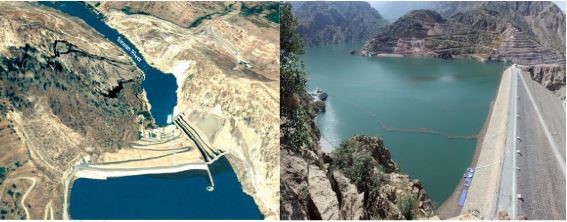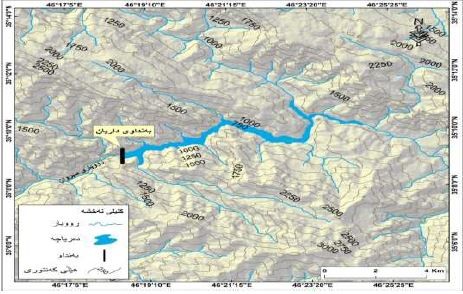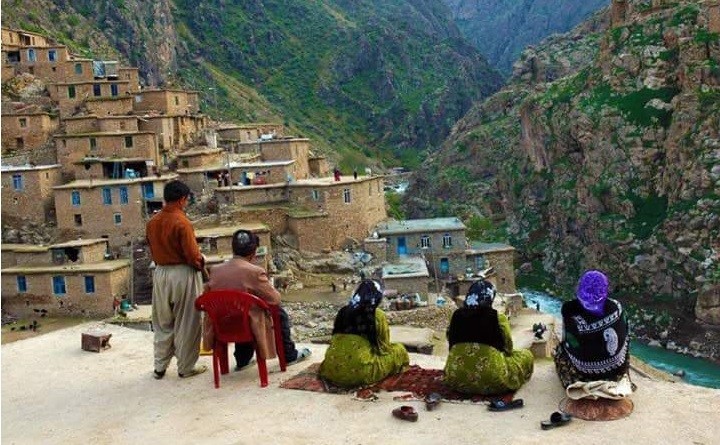In another article, it is discussed how Iran's water policy, especially dam construction and changing the natural course of the border rivers in order to transport the water of the East part of Kurdistan to the central regions of Iran forms a part of the "Environmental Colonialism" of the Iranian state. Here, we highlight the effects of the "Daryan Dam" on the social life and economic situation of the Hawraman district in the East part of Kurdistan as with the construction of this dam many ancient villages, historical monuments on the riverbanks of the Sirwan River, forests, gardens, pastures and most of "Bil" Spring have been submerged.

Daryan Dam on Sirwan River
Within the framework of the Iranian government's water policy and project, more than ten dams have been constructed on the Sirwan River and its branches, the most important of which is the "Daryan Dam". The dam is located in Kermashan Province in the East part of Kurdistan and is 28.5 kilometers away from the South part of Kurdistan's border; it was built near the city of Paveh and next to Daryan and Hajin villages in 2009 and was opened in 2018. The width of the dam reaches 316 meters and on the top of it is 15 meters wide and its height reaches 155 meters. This dam has the capacity to collect 316 million cubic meters of water. The idea of this project is not new and dates back to 70 years ago when World War II and later during the reign of the Islamic Republic of Iran the Iran-Iraq war prevented it from being carried out.

The map of Daryan Dam
The Iranian government says the dam on the Sirwan River and its branches are intended to restore water from the river by transporting it through the Nowsud water transport tunnel- which is 48 kilometers long- to provide drinking and irrigated water for residents and the plains of the eastern provinces of Sna, western Kermashan, and Ilam province. Part of this project is dedicated to the production of hydroelectric power. However, in fact, the main goal is to transport much of the river's water to the central regions of Iran.

Part of the interior view of the Nowsud water restoration tunnel
In addition to the devastating losses on the Sirwan River, and the destruction of the environment and ecosystem of the area, the construction of the dam has a huge negative impact on the livelihood of the villagers living in this area. Since the economic and income sources of Hawraman villages are largely related to agriculture, gardening, livestock, etc. with the construction of this dam, many of the people of Hawraman especially the villages of Hajij, Rwar, Slen, and Bilbar have faced a reduction of income. The main reason is that a significant part of the land and pastures of that area has gone underwater because of the dam and the paths or the ways of access to the people of villages have been destructed or closed completely in many places. For example, the dam, even though it was the reason for the displacement of most parts of Hajij village, also completely destroyed Rwar village and it destroyed the mountainous trails and pastures forever. This has led to a decline in migratory lifestyle, livestock, and gardening of these villages that are located on the riverbank of Sirwan, and the "Shaho" and "Kosalan" Mountains. The dam has also changed the climate of the area and despite the danger to the ecosystem of the region, it has caused a lot of damage to the walnut orchards and pomegranate gardens of the villages on the edge of the dam.
On the other hand, the Iranian state media and tourism agencies are constantly promoting the development of the Hawraman area due to the construction of the dam, and from a superficial and naïve point of view, they identify the dam as the pillar of growth in this area. However, the fact is that all of these negative effects on the economy and the livelihood of the region have led to the migration of people to Marivan, Paveh, and Kermashan. At the same time, the construction of the dam and forced immigration of at least hundreds of families especially in "Hajij", "Rwar" and "Daryan" villages have displaced a large population of people. Furthermore, the dam is a danger to the traditional, cultural, and social system causing fear of the loss of historical-cultural identity, harmony, and local costumes resulting in the indirect decline of social capital in the Hawraman region.

The Kurdish environmentalists have never been ignorant of this dangerous phenomenon. In 2015, a social media campaign called "Save Bil Spring Campaign" was launched across the eastern part of Kurdistan. The people of Hawraman district repeatedly called on the government to save Bil Spring and some activists went on a food strike and demanded the protection of water resources. All these efforts were able to put pressure on the relevant agencies to protect the flowing spring but unfortunately, the dam has dried up much of the water and Sirwan River.
In addition to the impact of the dams on the elimination of the development of the East part of Kurdistan, it also poses significant risks to the biodiversity and socio-economic integration of the South part of Kurdistan which will be discussed in another article.









